
Cart
CloseNo products in the shopping cart.

No products in the shopping cart.
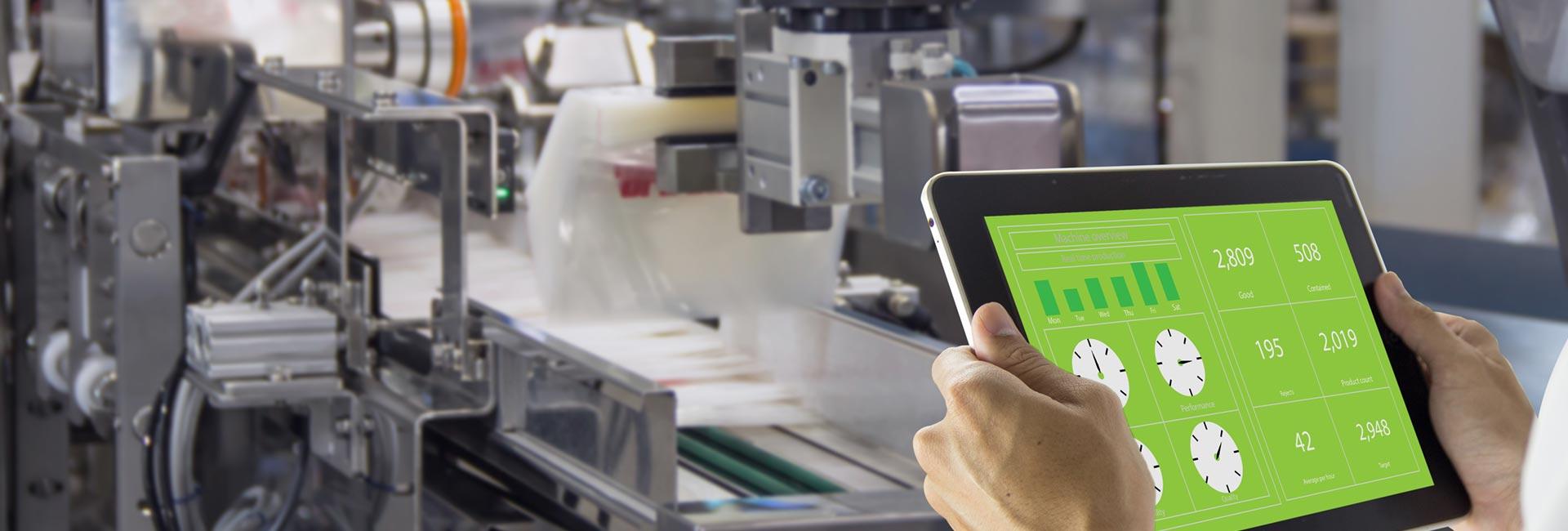
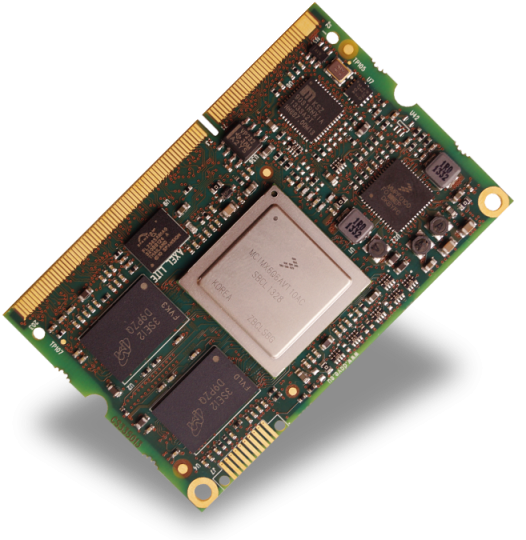

AXEL Lite - i.MX6
 Processor: NXP/Freescale i.MX6
Processor: NXP/Freescale i.MX6
AXEL LITE is the new top-class Single - Dual - Quad Core ARM Cortex-A9 CPU module by DAVE Embedded Systems, based on the recent NXP/Freescale i.MX6 application processor. Thanks to AXEL LITE, customers have the chance to save time and resources by using a compact solution that permits to reach scalable performances that perfectly fits the application requirements avoiding complexities on the carrier board.
The use of this processor enables extensive system-level differentiation of new applications in many industry fields, where high-performance and extremely compact form factor (67,5 mm x 45 mm) are key factors. Smarter system designs are made possible, following the trends in functionalities and interfaces of the new, state-of-the-art embedded products. AXEL LITE offers great computational power, thanks to the rich set of peripherals, the Scalable ARM Cortex-A9 together with a large set of high-speed I/Os.
AXEL LITE enables designers to create smart products with the best quality/price ratio.
Thanks to the tight integration between the ARM Core-based processing system, designers are able to share the applications through the multicore platform and/or to divide the task on different cores in order to match with specific application requirements (thanks to AMP it is possible to create applications where RTOS and Linux work together on different cores).AXEL LITE is designed in order to keep full compatibility with the LITE Line CPU modules, for designs where quality and reliability are important factors. AXEL LITE is suitable for high volume applications where the price/quality ratio is important such as Home Automation.
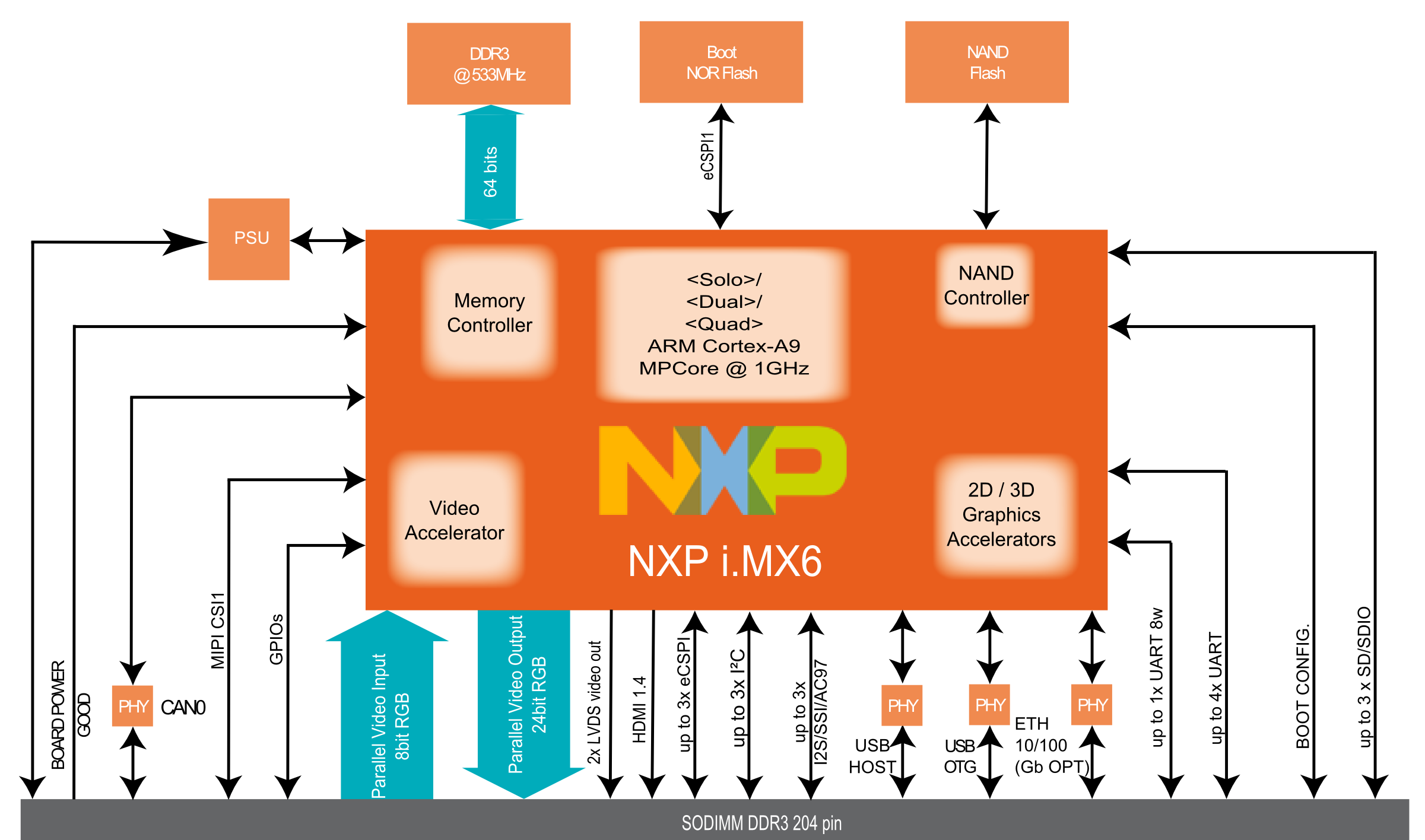
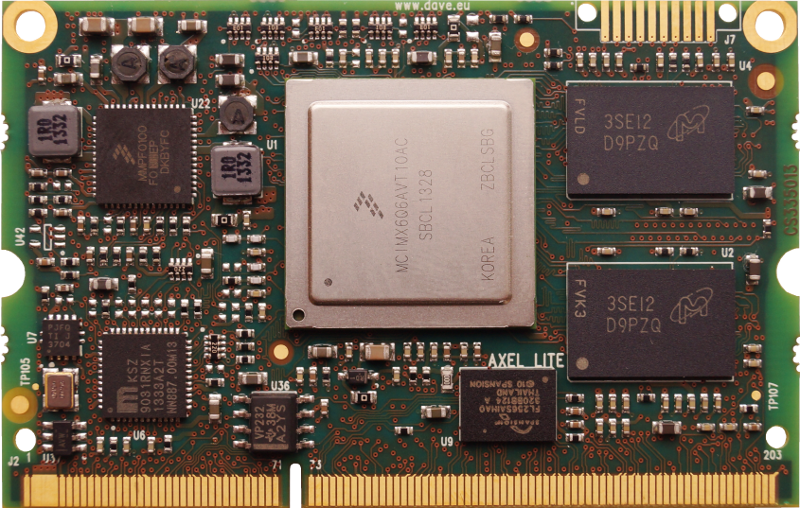
|
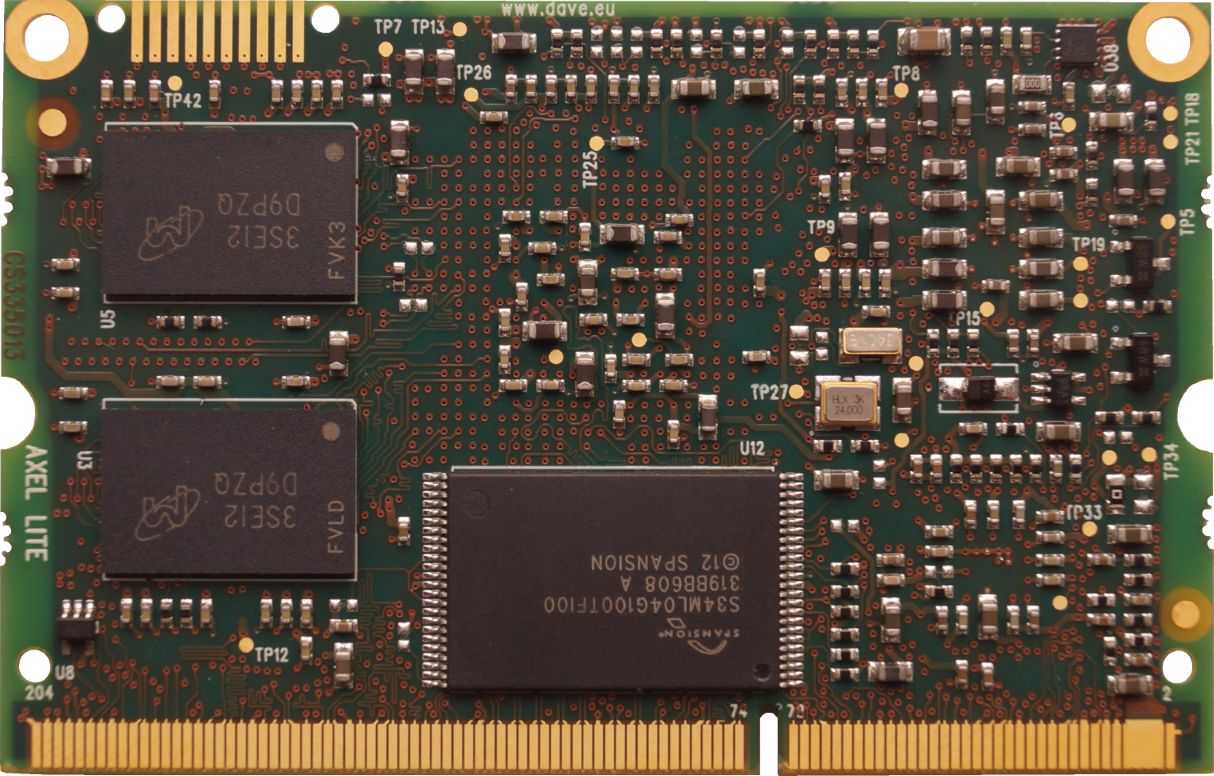
|
CPU |
|
| Supervisor |
|
| Memory |
|
| Cache |
|
| Interfaces (full-spec models)* |
|
| Mechanical |
|
Power Supply |
|
| Connectors and Pinout | ||
| Power and Reset | ||
| Peripherals | ||
| Electrical, Thermal and Mechanical Features | ||
|
|
||
|
|
||
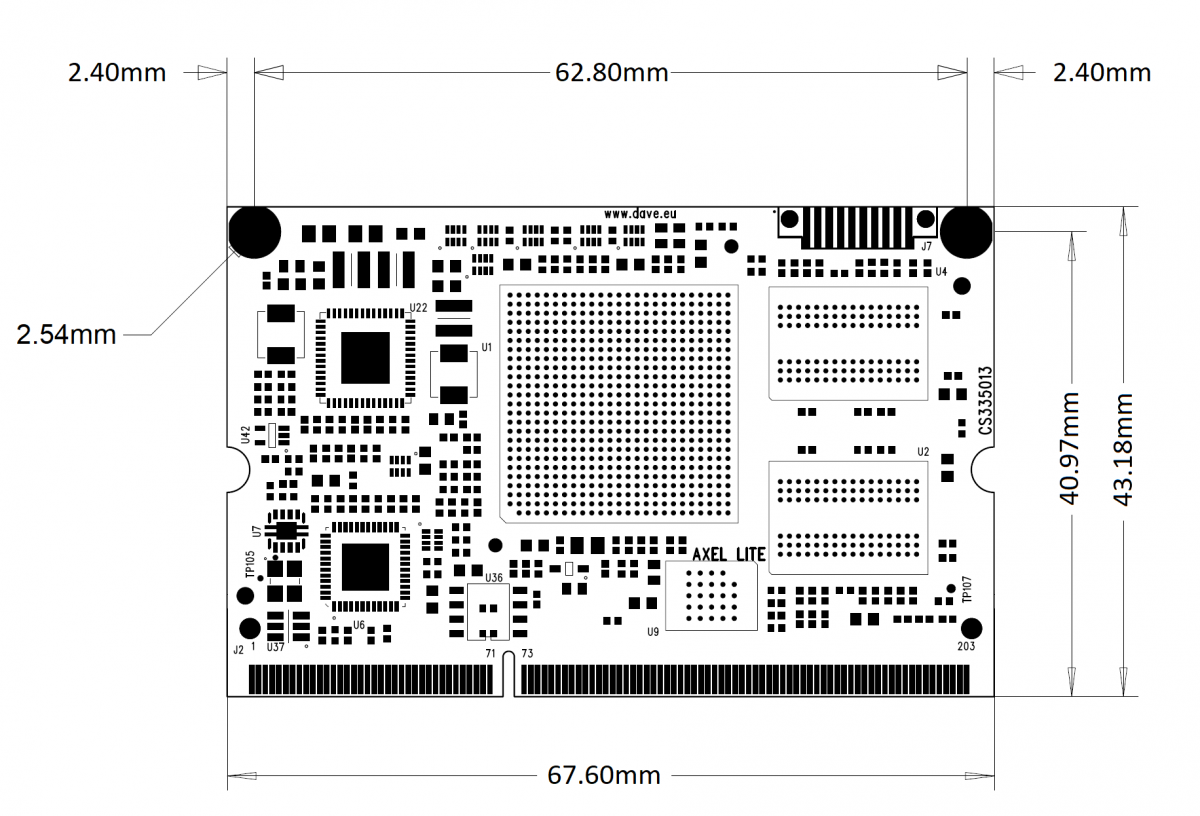
|
||

|
||
DAVE Embedded Software Kit Linux (DESK-MX6-L in short - read more info about the naming) - provides all the necessary components required to set up the developing environment to:
The Embedded Software kit is composed by:
Genereral Information |
|
Development |
|
Deployment |
|
Peripherals |
The official evaluation kit for AXEL Lite SOM. This solution includes a SOM and all necesary for the fast and easy evaluation
There are no PCN for AXEL Lite SOM
Hello world C ![]() wiki
wiki
How to create and cross-compile the first C source code application: the classic Hello World.
Hello world Python ![]() wiki
wiki
An example of using the embedded Python interpreter language. The python3 is provided by default into dave-image-devel-desk DAVE Embedded Systems' standard Yocto distribution.
Flutter embedded ![]() wiki
wiki ![]() video
video
Flutter application can easily run once the flutter runtime is installed in the target.
Java Virtual Machine ![]() wiki
wiki
Performance comparison of different free available JVMs.
Node.js ![]() wiki
wiki ![]() video
video
How to install node.js and using a GPIO or create a web server.
Chromium browser ![]() video
video
A web-based application can run in the target using the embedded Chromium available in the desk-image-x11-browser-desk-mx6.wic.bz2 SD image built with Yocto.
Date and Time ![]() wiki
wiki ![]() video
video
How to keep system date and time synchronized using the NTP services.
Package management ![]() wiki
wiki ![]() video
video
It is possible to install other - already built - packages in the target using dnf package manager.
Framebuffer capture ![]() wiki
wiki ![]() video
video
Using fbgrab utility, it is possible to capture a framebuffer screenshot.
GPIOs ![]() wiki
wiki ![]() video
video
The custom hardware device tree can be properly modified for adding led and pushbuttons control via native led class and key event input kernel devices.
eth1 ethernet interface ![]() wiki
wiki ![]() video
video
On AXEL Lite SOM - based on i.MX6 system-on-chip which has only one ethernet interface - it is possible to easily add a second ethernet interface (i.e. eth1) just connecting an USB ethernet adapter.

Yes. The PCB version is copper printed on PCB itself and the serial number is printed on a white label (please see here for further information). Also, a ConfigID is used by software running on the board for the identification of the product model/hardware configuration.
Click here to see in what areas AXEL Lite SOM ConfigID is stored.

Here you can find the connectors and pinout description of the AXEL Lite SOM.


Implementing correct power-up sequence for i.MX6 processors is not a trivial task because several power rails are involved. AXEL Lite SOM simplifies this task by embedding all the needed circuitry. Here you can find a simplified block diagram of PSU/voltage monitoring circuitry.
The PSU is composed of two main blocks: 1) a power management integrated circuit, 2) an additional generic power management circuitry that completes PMIC functionalities. The PSU:
The typical power-up sequence is the following:
For further information, see this page.

Here you can find a block diagram of reset scheme and voltage monitoring.

The boot process begins at Power On Reset (POR) where the hardware reset logic forces the ARM core to begin execution starting from the on-chip boot ROM.
The boot ROM:
For further information about AXEL Lite SOM boot options, please check out more by clicking here.

JTAG signals are routed to a dedicated connector on the AXEL Lite PCB. The connector’s position and the connector’s pinout are shown on this page.
For further information on how to use the JTAG interface, please contact the Technical Support Team.

Yes, we have our Longevity Program based on Silicon Vendors' Longevity Program NXP i.MX6. For AXEL Lite see this page.
In this video, we explain how to check the longevity of DAVE Embedded Systems' products: DAVE Embedded Systems / HOW TO - How to check product Longevity

On this page, you can find AXEL Lite SOM’s maximum ratings, recommended ratings and power consumption.

The AXEL Lite SOM is designed to support the maximum available temperature range declared by the manufacturer. The customer shall define and conduct a reasonable number of tests and verification in order to qualify the DUT capabilities to manage the heat dissipation. Any heatsink, fan etc shall be defined case by case.
DAVE Embedded Systems' team is available for any additional information, please contact sales@dave.eu or see this page for further information.

On this page, you can find the mechanical characteristics of the AXEL Lite SOM.

Yes. DAVE Embedded Software Kit Linux (DESK-MX6-L in short) provides all the necessary components required to set up the developing environment to:
• build the bootloader (U-Boot)
• build the Linux operating system
• build Linux applications that will run on the target
• build the Yocto BSP
Click here for further information about DESK-MX6-L.

DESK-MX6-L (Software Development Kit for AXEL Lite SOM) is composed by:

DAVE Embedded Systems strongly recommend to register your kit. Registration grants access to reserved material such as source code and additional documentation.
To register your kit, please send an email to helpdesk@dave.eu providing the kit P/N and S/N.

Check this page for all the DESK-MX6-L releases information.

DESK-MX6-L (Software Development Kit for AXEL Lite SOM) contains all the required software and documentation to start developing Linux application on the AXEL platform. In particular, DESK-MX6-L provides a virtual machine called DVDK.
For further information, see this page.

Yes. ConfigID is a new feature of DAVE Embedded Systems products. Its main purpose is providing an automatic mechanism for the identification of the product model and configuration. In simple words, model identification means the capability of reading a numerical code, stored in an available device (SOC's OTP , I2C EEPROM, 1-wire memories, protected NOR flash, etc.)
With ConfigID, we aim at completing the hardware configuration information that the software can't normally auto-detect (i.e. RAM chip version,...), implementing a dedicated reliable detect procedure and, when required, overriding the auto-detected hardware configuration information.
This article describes how the ConfigID is implemented in the products supported by the DESK-MX6-L Linux Kit.
An additional attribute is UniqueID, which is a read-only code which univocally identifies a single product and is used for traceability.
For further information, see this page.

Yes, you can boot DESK-MX6-L (Software Development Kit for AXEL Lite SOM) from NFS. This configuration is very helpful during the software development (both for kernel and applications). The kernel image is downloaded via TFTP while the root file system is remotely mounted via NFS from the host.
For further information, see this page.

On this page you will find the detailed explanation on how to keep in sync and up to date the source trees with DAVE Embedded Systems' repositories.
Access to DAVE Embedded Systems' git repositories is granted to the development kit's owners only. Please refer to our video tutorial How to access DAVE Embedded Systems' git repositories for detailed instructions on how to get access.

See this page for further information on how to build the U-Boot bootloader on DESK-MX6-L.

See this page for further information on how to build the Linux kernel on DESK-MX6-L (Software Development Kit fo AXEL Lite SOM).
Please refer to our video tutorial How to add a new kernel device driver (build the kernel) for detailed instructions on how to do it.

As known, in addition to a bootloader and the o.s. kernel, an embedded Linux system needs a root file system to operate. The root file system must contain everything needed to support the Linux system (applications, settings, data, etc.). The root file system is the file system that is contained on the same partition on which the root directory is located.
To generate the supported root file systems, the build of the Yocto BSP has to be run. The output of this process is an image containing the U-Boot binary file, the Linux kernel image, and the selected root file system image. See this page for further information on how to build the Yocto BSP on DESK-MX6-L.

See this page for further information on how to create a bootable microSD for the DESK-MX6-L kit by using a simple bash script.
In this video tutorial we guide you step by step in creating a bootable SD card from scratch.

Yes. On this page you can find an example on C code displaying the classic Hello World! message on the target serial console. This example shows how to use the arm cross-compiler using the environment configured for this purpose.

With respect to the NOR flash memories, NAND devices are known to be quite challenging with regard to the reliability. This is especially true when the NAND flash is used as the boot device. Several techniques such as wear leveling and bad block management have to be implemented to achieve an acceptable reliability.
This page provides information about the NAND device management, in order to handle it properly when it is used as the boot device on NXP i.MX6-based products.
Please refer to our video tutorial How to program U-Boot in NAND flash for detailed instructions on how to program and U-Boot on internal NAND flash.

On this page you can find further information on how to customize the splash screen on DESK-MX6-L (Software Development Kit for AXEL Lite SOM).
Please refer to our video tutorial How to change the U-Boot splash screen on SD card for detailed instructions on how tto use your own company logo as a U-Boot splash screen.

On this page you can find how to program and configure a SOM to boot in standalone mode, without the need of a system microSD card or an NFS server. The page contains general concepts that can be adapted on any DAVE Embedded Systems' Linux platform.
Please refer to our video tutorial How to program the NAND flash for a standalone boot for detailed instructions on how to do it.

For deploying an Embedded System, one of the most important configuration is the Network Interface configuration.
Once the Embedded Device is finally configured for stand-alone bootstrap, the network interface should be configured for reaching the device remotely via network connections like ssh, telnet, ftp, http, etc.
Visit this page for further information on how to simply configure the network interface or watch our tutorial How to configure the network interface.


Yes. AXEL Lite Evaluation Kit includes a SOM and all the necessary for the fast and easy evaluation. For the product highlights, please see this page.

Yes. You can download AXEL Lite Evaluation Kit hardware manual by clicking here.
To download the technical documentation you will need to register on the DAVE Embedded Systems Wiki site. You can find the video tutorial with the guided procedure by clicking here: How to register to the DAVE Embedded Systems website.

On this page you can find a simplified block diagram of the AXEL Lite SOM Evaluation kit and a summary for the main characteristics of the Kit.

If you’re interested in AXEL Lite SOM Evaluation Kit contact us to get a quotation.

All the developments kits by DAVE Embedded Systems are identified by a couple of codes: the Part Number identification code (P/N) and the Serial Number identification code (S/N).
These codes are printed on a label sticked to the box containing the kit. For further information, see this page.

Here you can find the guide to unbox the AXEL Lite SOM Evaluation Kit that shows you how the Evaluation Kit is composed and how to unbox and connect it to the development platform.
Once you've received the kit, please open the box and check the kit contents with the packing list included in the box, using the table on this page as a reference. The hardware components (SOM, carrier boards and display) are pre-assembled.

On this page you can find how to quick start the Evaluation Kit. The system is programmed to automatically boot Linux at power up, loading the bootloader, the kernel and device tree image and the root file system from the SD card memory.
Once power has been applied, U-Boot bootloader will be executed and the debug messages will be printed on the serial console. U-Boot automatically runs the autoboot macro, that loads the kernel/dtb and launches it with the options for mounting the root file system from the SD card. At the end of the boot process, a demo application is launched and you can interact with the system using the touchscreen.

AXEL Lite Evaluation Board is built upon i.MX6 family processor. On this page you can find the options available for the boot configuration.

AXEL Lite Evaluation Board has a pushbutton directly connected to the PMIC_PWRON signal which drives a SOM hardware reset. S3 is the hardware reset button, as shown on this page.

Yes. This page provides useful information and resources to system designers in order to design carrier boards hosting DAVE Embedded Systems system-on-modules (SOM).
These guidelines are provided with the goal to help designers to design compliant systems with DAVE Embedded Systems modules and they cover schematics and PCB aspects.


On this page you can find the links for the AXEL Lite Evaluation Kit schematics and the related documents (BOM and layout).

On this page you can find the mechanical characteristics of the AXEL Lite Evaluation Kit.

The AXEL Lite's part number composition is available at this link on Wiki

AXEL Lite SOM Yocto images contain a list of pre-built packages and applications. A summary of root file system images and the complete list of installed packages can be checked in the following table.

On this page you will find the roadmap for all DAVE Embedded Systems products, with detailed release history of our SOMs and previews of future updates.

AXEL Lite is supported from DESK-MX6-L and its documentation is available on wiki.dave.eu. If needed, is also available in PDF version.
To download the technical documentation you will need to register on the DAVE Embedded Systems Wiki site. You can find the video tutorial with the guided procedure by clicking here: How to register to the DAVE Embedded Systems website.

In this video tutorial, we take you step-by-step through the creation and startup of the Virtual Machine of DESK-MX6-L, the Software Development Kit of the SOM AXEL Lite.

In this video tutorial, we guide you step by step in creating and running the first HelloWorld application on the AXEL Lite Evaluation Kit.

AXEL LITE is the top-class Single - Dual - Quad Core ARM Cortex-A9 CPU module by DAVE Embedded Systems. You can download AXEL Lite SOM brochure by clicking here.

If you’re interested in AXEL Lite SOM contact us to get a quotation.

The AXEL Lite SOM product is based on NXP/Freescale i.MX6 application processor.
The use of this processor enables extensive system-level differentiation of new applications in many industry fields, where high-performance and extremely compact form factor (67,5 mm x 43 mm) are key factors.

AXEL Lite is designed in order to keep full compatibility with the Lite Line CPU models, for designs where quality and reliability are important factors.

AXEL Lite enables designer lo create smart products suitable for harsh mechanical and thermal environments, allowing for the development of high computing and reliable solutions.
Also, AXEL Lite is suitable for high volume applications where the price/quality ratio is important such as Home Automation, portable solutions, Human Machine Interfaces and Industrial Automation.

AXEL LITE is the new top-class Single - Dual - Quad Core ARM Cortex- A9 CPU module by DAVE Embedded Systems, based on the recent NXP i.MX6 application processor.
AXEL Lite offers great computational power, thanks to the rich set of peripherals, the Scalable ARM Cortex-A9 together with a large set of high-speed l/Os.
Thanks to the tight integration between the ARM Core-based processing system, designers are able to share the applications through the multicore platform and/or to divide the task on different cores in order to match with specific application requirements (thanks to AMP it is possible to create applications where RTOS and Linux work together on different cores).

On this page you can find AXEL Lite SOM 3D model.

On this page you can find AXEL Lite SOM block diagram.

On this page you can find AXEL Lite SOM hardware manual.

On this page you can find all the AXEL Lite SOM marketing documentation available.

AXEL Lite SOM module part number is identified by the digit-code table that you can find here.

DAVE Embedded Systems' goal is to grant the production continuity to its customer including the possibility to redesign its products in order to maintain the product continuity.

If you want to request support to our technical team please fill this form. After the submission, a ticket will be assigned. Our technicians will look after your request and, typically, they will respond you via email within 24 hours from the request.
DAVE Embedded Systems provides a very efficient technical support via a helpdesk ticketing system. In this video we show you all the ways you can get help from us: How to contact DAVE technical support.

On this page you can find the DAVE Embedded Systems' Return Material Authorization form.

Yes. You can download AXEL Lite SOM hardware manual by clicking here.
To download the technical documentation you will need to register on the DAVE Embedded Systems Wiki site. You can find the video tutorial with the guided procedure by clicking here: How to register to the DAVE Embedded Systems website.

AXEL Lite SOM’s processor and memory subsystem are composed by the following components:
For further information, see this page.
Welcome to the DAVE Embedded Systems' technical information form submission portal!
Please fill in the fields below. The support team will take care of you in maximum 24h!
Welcome to the DAVE Embedded Systems' Documentation system. Please fill in with required information and you will get your document! Thank you!.
We use cookies to personalize content, to get traffic statistics and to improve your experience on our website.
Please read our Cookie Policy for a more detailed description and click on the "Manage preferences" button to customize how the site uses cookies for you. By clicking on "Accept all cookies" you give your consent for the use of each type of cookie.
These cookies are necessary for the website to function and cannot be switched off in our systems.
You can set your browser to block or alert you about these cookies, but some parts of the site will not then work. These cookies do not store any personally identifiable information.
These cookies allow us to count visits and traffic sources so we can measure and improve the performance of our site. They help us to know which pages are the most and least popular and see how visitors move around the site.
All information these cookies collect is aggregated and therefore anonymous. If you do not allow these cookies we will not know when you have visited our site, and will not be able to monitor its performance.
Select all Deselect all